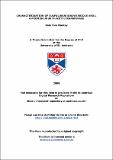Files in this item
Characterisation of Sulfolobus solfataricus Ard1, a promiscuous N-acetyltransferase
Item metadata
| dc.contributor.advisor | White, Malcolm F. | |
| dc.contributor.advisor | Taylor, Garry L. | |
| dc.contributor.author | Mackay, Dale Tara | |
| dc.coverage.spatial | 209 | en |
| dc.date.accessioned | 2008-04-23T14:13:19Z | |
| dc.date.available | 2008-04-23T14:13:19Z | |
| dc.date.issued | 2008-06-27 | |
| dc.identifier.uri | https://hdl.handle.net/10023/468 | |
| dc.description.abstract | Compaction of DNA into chromatin is an important feature of every living cell. This compaction phenomenon is brought about and maintained by a variety of DNA binding proteins, which have evolved to suit the specific needs of the different cell types spanning the three kingdoms of life; the eukaryotes, prokaryotes and archaea. Sulfolobus solfataricus, a member of the crenarchaeal subdivision of the archaea, has two prominent DNA binding proteins known as Alba (1&2) and Sso7d. Alba1 is acetylated in vivo at two positions and this modification lowers its’ affinity for binding DNA. Acetylation levels impact many cellular processes and in higher organisms play a critical role in the development of many cancers and other diseases. This thesis documents the finding and characterisation of the N-terminal acetyltransferase (ssArd1) of SsoAlba1, based on its’ sequence homology to the catalytic subunits Ard1, Nat3 and Mak3 belonging to the larger eukaryal Nat complexes NatA, NatB and NatC, respectively. Mutagenesis studies revealed that ssArd1 preferentially acetylates N-termini bearing a serine or alanine residue at position 1 (after methionine cleavage). It is also capable of acetylating other proteins with very different physical structures. These findings allow classification of ssArd1 as a promiscuous acetyltransferase belonging to the Gcn5-N-acetyltransferase (GNAT) superfamily. The active site of the enzyme was examined through mutagenesis studies, revealing that the mechanism of acetylation is likely to proceed through a direct acetyl transfer involving a tetrahedral intermediate. Structural studies provided some insight into the molecular structure of ssArd1. | en |
| dc.format.extent | 11908437 bytes | |
| dc.format.mimetype | application/pdf | |
| dc.language.iso | en | en |
| dc.publisher | University of St Andrews | |
| dc.rights | Creative Commons Attribution 3.0 Unported | |
| dc.rights.uri | http://creativecommons.org/licenses/by/3.0/ | |
| dc.subject | Sulfolobus | en |
| dc.subject | Acetylation | en |
| dc.subject.lcc | QR82.A69M6 | |
| dc.subject.lcsh | Acetyltransferases | en |
| dc.subject.lcsh | Archaebacteria | en |
| dc.subject.lcsh | Thermophilic bacteria | en |
| dc.subject.lcsh | Sulfur bacteria | en |
| dc.title | Characterisation of Sulfolobus solfataricus Ard1, a promiscuous N-acetyltransferase | en |
| dc.type | Thesis | en |
| dc.contributor.sponsor | Biotechnology and Biological Sciences Research Council (BBSRC) | en |
| dc.type.qualificationlevel | Doctoral | en |
| dc.type.qualificationname | PhD Doctor of Philosophy | en |
| dc.publisher.institution | The University of St Andrews | en |
This item appears in the following Collection(s)
Except where otherwise noted within the work, this item's licence for re-use is described as Creative Commons Attribution 3.0 Unported
Items in the St Andrews Research Repository are protected by copyright, with all rights reserved, unless otherwise indicated.


